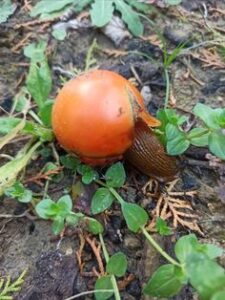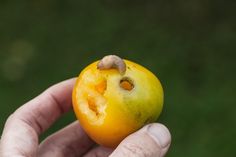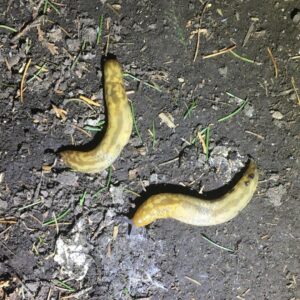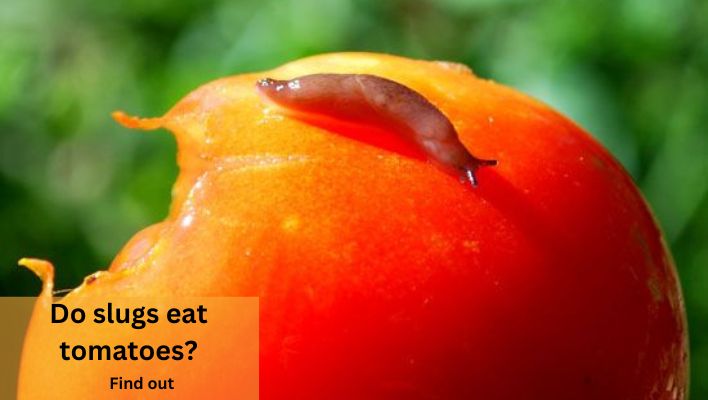There’s nothing like biting into a ripe, juicy tomato you’ve nurtured from a tiny seedling. However, that joy can quickly turn to frustration when you find that pests have eaten your prized tomatoes.
Tomatoes are a popular and delicious crop many gardeners enjoy growing in their backyards. However, gardeners often face challenges when protecting their precious tomato plants from pests that can cause damage or even destroy the entire crop. One such pest that is commonly found in gardens is the slug.
Slugs are soft-bodied creatures known to feed on various plant species, but do they eat tomatoes?
This is a common question among gardeners, and in this blog post, we’ll explore the answer to this question in detail. We’ll take a closer look at slugs, their behavior, and their feeding habits, and we’ll examine whether they threaten tomato plants.
Additionally, we’ll provide tips and strategies for managing slugs in your garden and protecting your tomato plants from damage. So, let’s dive in and learn more about whether or not slugs eat tomatoes.
Slugs eat Tomatoes
Slugs are soft-bodied, slimy creatures you may have seen crawling around your garden. They are known to be voracious eaters, and unfortunately, they have a taste for tomatoes.
Slugs can eat tomatoes if they can get to it. Tomatoes are a favorite food of many types of pests, including slugs. They are attracted to the sweet smell of ripe tomatoes and will come right up to them in search of a tasty treat. They will feed on your tomato plants’ roots, stems, and foliage.

Slugs are particularly fond of ripe, juicy tomatoes, and they can cause serious damage to your plants if left unchecked.
While they do not cause significant damage to tomato plants themselves, they can lead to many problems if left unchecked.
If you find slugs on your tomato plants, it is time to take action immediately. You should remove them from your garden using organic means such as baits or traps, so they don’t have access to other parts of your garden or home grounds.
Slug damage on tomatoes
Slugs, those slimy creatures that crawl into our gardens, can cause significant damage to our beloved tomato plants. These pesky critters have a particular affinity for young tomato seedlings, often chewing through the stem and leaves, leaving behind a trail of destruction.
Tomato plants are susceptible to slug damage because they are shallow-rooted and slow-growing, making them easy targets for slugs who want to munch on the tender leaves.
As the tomato plant grows, slugs continue to pose a threat by gnawing on the ripe fruit, leaving unsightly holes and blemishes. The damage caused by slugs can weaken the plant, making it more susceptible to disease and other pests.
Slug damage can be easy to spot because the slug has left behind a characteristic slime trail when it moves from plant to plant; slugs often use this slime to mark their territory. In addition, you may notice that the leaves at the base of your tomato plants have been nibbled or eaten away.
This can happen if the slug has got onto your tomato plants through their roots and caused damage there too. When you have slugs in your garden, the first thing you should do is check for signs of slug damage on your plants: dead leaves or flowers, patches of bare soil where the plants have been eaten away, or even brown spots that are starting to form where there was once a healthy plant or two.

How to naturally get rid of slugs on tomatoes
Slugs are a common problem in the garden, and they love tomatoes. But when it comes to getting rid of slugs eating tomatoes, you can do a few things you can do
Slug traps:
One effective method to get rid of slugs is by using slug traps and bait. It’s a simple yet effective way to lure and trap these slimy creatures before they can feast on your plants.s
To create a slug trap, you’ll need a container with a lid, such as a plastic yogurt or sour cream container. Cut a small hole in the side of the container, big enough for a slug to crawl through. Then, bury the container in the soil, leaving the lip of the container at ground level.
Next, fill the container with beer or a sugar and water mixture. The smell of beer or sugar will attract the slugs, and once they crawl into the container, they will drown and won’t be able to get out.
Slug pellets:
These pellets are designed to kill slugs and snails, so they’re safer for your garden than just using traditional pesticides. You can buy them in most garden centers or online.
They come in different sizes, so make sure you pick one that matches the size of your tomato plants. You’ll also need to find a place where you can place them so they can work their magic.
Slug pellets are easy to use, just sprinkle them around your tomato plants every 2-3 weeks until you see fewer slugs around.
Spray organic insecticides:
Organic insecticides are made from natural ingredients that are safe for humans and the environment. Some of the commonly used organic insecticides include neem oil, garlic oil, and vinegar. These insecticides work by repelling or killing the slugs, making them less likely to feed on the tomatoes.
Mix the solution according to the instructions on the bottle to use organic insecticides to get rid of slugs. Then, spray the mixture directly onto the tomato plants, paying extra attention to the leaves and fruits. Make sure to reapply the insecticide every few days or after rainfall to ensure the slugs stay away.
Encourage natural predators:
Slugs have many natural predators, such as birds, toads, and ground beetles. You can attract birds to your garden by providing birdhouses, feeders, and birdbaths. Toads can be attracted by creating moist, shady areas for them to hide in. Ground beetles can be attracted by providing ground covers such as straw or mulch.
You can also plant companion plants that repel slugs, such as herbs like thyme and rosemary, or flowers like marigolds and calendula. These plants have strong scents that deter slugs.
Physical barrier:
Tomatoes are a delicious and nutritious fruit that many gardeners love. Unfortunately, slugs also love them, which can be a nuisance for gardeners. Suppose you are looking for a natural way to get rid of slugs eating your tomatoes. In that case, one effective method is to use physical barriers.
Slugs are slow-moving creatures that cannot climb over or tunnel under physical obstacles, so creating a barrier is an effective way to keep them away. Here are some natural barriers you can use:
- Copper tape: Copper tape is a natural slug repellent that produces a mild electric shock when slugs come into contact with it. Simply wrap the tape around the base of your tomato plants or create a ring around them. This will create a barrier that slugs cannot cross.
- Diatomaceous earth: Diatomaceous earth is a natural powder made from fossilized diatoms. It is effective at killing slugs by dehydrating them. Simply sprinkle the powder around the base of your tomato plants, creating a barrier that slugs cannot cross.
- Wool pellets: Wool pellets are another effective slug repellent that works by absorbing moisture from the slugs’ bodies, causing them to dry out. Simply scatter the pellets around the base of your tomato plants to create a barrier.
- Gravel: Gravel is an effective natural barrier that slugs cannot cross. Simply create a ring of sand around your tomato plants to keep slugs away.
By using physical barriers, you can effectively protect your tomato plants from slugs without the use of harmful chemicals. Just remember to choose an effective barrier and maintain it regularly to ensure its effectiveness.

Use borax to kill slugs.
These slimy creatures can quickly munch through entire plants, leaving behind nothing but bare stems and ruined fruit. While many chemical pesticides are available to deal with slugs, these can harm both the environment and the beneficial insects in your garden. Fortunately, there is a natural way to get rid of slugs that is effective and safe for your plants.
One of the most popular natural remedies for slugs is to use of borax. Borax is a naturally occurring mineral often used as a cleaning agent. However, it is also an effective slug repellent, as it dehydrates and kills pests. To use borax to get rid of slugs, you will need the following:
- Borax powder
- Water
- Spray bottle
- Garden gloves
Here are the steps to follow:
- Mix borax powder with water in a spray bottle. The recommended ratio is 1 tablespoon of borax per 1 liter of water. Shake the bottle well to ensure that the borax is fully dissolved in the water.
- Put on your garden gloves to protect your hands from the borax solution.
- Spray the borax solution directly onto the soil around your tomato plants. Make sure to spray all around the base of the plants and cover the soil thoroughly.
- Reapply the borax solution every 2-3 days or as needed. This will help keep slugs at bay and do not return.
You can also sprinkle borax directly onto the soil around your plants, but be careful not to get it on the leaves or fruit. Borax can be harmful if ingested, so keep it away from any part of the plant you plan to eat, or rinse before eating.
By using borax and other natural methods to get rid of slugs, you can keep your tomato plants healthy and thriving without harming the environment or beneficial insects in your garden.
Use sticky tape
Place sticky tape around the base of each tomato plant. Make sure it’s long enough to reach down to the soil. The tape should be sticky and gooey so that it sticks well to the slug’s body but doesn’t stick too much and gets stuck on your hands when you try to remove it later. Here is a step to follow:
- Choose a type of sticky tape that is wide enough to cover the stem of the tomato plant and long enough to wrap around it several times.
- Wrap the sticky tape around the stem of the tomato plant, making sure to cover the entire circumference of the stem. The sticky tape should be tight enough to prevent slugs from crawling over it.
- Check the tape regularly and replace it as needed. The tape may become less sticky over time or become covered in debris, so keeping it clean and fresh is important.
Use this method consistently to deter slugs from eating your tomatoes. Over time, the slugs will learn that the tomato plants are not a good food source and will move on to other plants.
Overall, using sticky tape is an effective and natural way to protect your tomato plants from slugs. It’s easy to do and requires no harmful chemicals, making it a safe and environmentally-friendly option.
Diatomaceous earth:
Diatomaceous earth is a fine powder that is made up of the fossilized remains of diatoms, a type of algae. The powder is made up of tiny, sharp particles that can pierce the soft bodies of slugs and other garden pests, causing them to dehydrate and die.
To use diatomaceous earth in your garden you need to buy and they are different brands available, here is our ideal brand. Simply sprinkle a thin layer around the base of your tomato plants or on the soil around them. Be sure to reapply after rainfall or watering to keep the powder dry and effective.
It’s important to note that diatomaceous earth is harmless to humans and animals but can also harm beneficial insects in your garden. To avoid this, only apply the powder directly to areas where slugs are present and avoid applying it to flowers or other plants that attract pollinators.
Using diatomaceous earth, you can naturally and effectively keep slugs at bay and enjoy a bountiful tomato harvest.
Companion planting
Companion planting is a natural and effective way to deter slugs from eating your precious tomato plants. Several companion plants are known to repel slugs and can be planted alongside your tomato plants to keep them safe.
- Mint: The strong scent of mint acts as a natural deterrent for slugs. Plant mint around the perimeter of your tomato bed or intersperse it throughout the bed.
- Garlic: The pungent smell of garlic keeps slugs away. Plant garlic cloves around your tomato plants or spray a garlic solution on the leaves of your tomatoes.
- Nasturtiums: Nasturtiums are beautiful and serve as a slug deterrent. Plant them around your tomato plants or scatter their leaves throughout the bed.
- Marigolds: Marigolds release a strong scent that repels slugs. Plant them around the perimeter of your tomato bed or scatter their flowers throughout the bed.
- Sage: The strong aroma of sage deters slugs. Plant sage around your tomato plants, or make a tea from sage leaves and spray it on your tomatoes.
In addition to companion planting, you can practice good garden hygiene by removing debris or weeds from your tomato bed. Slugs love to hide in damp and shady areas, so keep the area around your tomato plants clean and dry.
By implementing these natural methods, you can keep slugs away from your tomato plants and enjoy a bountiful harvest.
Peppermint oil
Peppermint oil is a natural repellent that slugs cannot stand. To use it, mix a few drops of peppermint oil with water in a spray bottle. Spray the mixture on and around your tomato plants, thoroughly covering the leaves and stems.
Peppermint oil can also be applied directly to the soil around your tomato plants. Simply mix a few drops of oil with water and pour it around the base of the plant. This will create a barrier that slugs will not cross.
Another way to use peppermint oil is to create a barrier around your garden. Mix a few drops of oil with water and spray it around the perimeter of your garden. This will help keep slugs from entering and eating your plants.
In addition to repelling slugs, peppermint oil has many other benefits for your garden. It can help deter other pests, like aphids and ants, and can even help improve the health of your plants.
Best slug repellent
Seeing slugs in your plants can be frustrating as a garden enthusiast or farmer. They can eat through your precious crops and leave you with nothing to show for your hard work. While there are numerous ways to control slugs in your garden, using the best slug repellent is the easiest and most effective way to keep them at bay. Below are some of the best to use
Monterey LG6500 Sluggo Wildlife and Pet Safe Slug Killer
The Monterey LG6500 Sluggo is an effective and safe way to control slugs without harming pets or wildlife. The active ingredient in this product is iron phosphate. This naturally occurring mineral is safe for use around humans and animals.
When slugs consume the pellets, they stop feeding and eventually die, making it an effective and humane method of controlling these pests.
The pellets are easy to apply; simply sprinkle them around your plants and water them in. They are also rain-proof and remain effective for up to two weeks. Unlike other slug repellents, the Monterey LG6500 Sluggo does not leave a harmful residue on your plants or soil, making it safe to use in vegetable gardens and around edible crops.
In addition to being pet and wildlife safe, this slug killer is also environmentally friendly. It is OMRI listed for organic use, and its active ingredient breaks down into fertilizer, adding nutrients to the soil. This product is also perfect for gardeners who want to avoid using harsh chemicals that may harm the environment.
Safer Brand SB125 Slug & Snail Killer
Slug and snail repellent is a safe, cost-effective way to keep slugs, snails, and other slug-like pests away from your plants. It’s proven effective in both indoor and outdoor areas and won’t harm pets or children as it is non-toxic and safe for use around them.
This product is less toxic than conventional pesticides and does not affect beneficial insects or birds.
Safe Brand’s SB125 Slug & Snail Killer kills slugs and snails on contact, with no need to hard treat or soak the ground. A ready-to-use solution that can be sprayed directly into cracks and crevices around foundations, building foundations, chimneys, and other areas in the home where the pests may be hiding.
It is safe to use, does not leave any stains on vegetables or grass, and smells unpleasant when you spray it around. The product can be used on vegetable beds in gardens, flower beds, and lawns without affecting their appearance.
Exterminators Choice Slug and Snail Spray
Exterminator’s Choice Slug and Snail Spray is a natural, safe, and effective solution to the problem of slugs and snails. Made of pine and cedar oil, organic compounds used since ancient times as a natural pesticide, this product will kill all slug species, including big brown, ratter, and two spots.
This spray provides a powerful liquid to eliminate and control snails, slugs, earwigs, and fleas. It is safe for use around pets and children but should not be used in direct contact with plants or eggs.
Lastly, exterminators Choice Slug and Snail Spray features Pristine pharmaceutical grade chemicals that are designed to provide a maximum effect on a broad range of target pests, including mites, ants, fleas, and roaches, while being safe for humans and pets.
Corry’s Slug & Snail Killer
Corry’s Slug & Snail Killer is the perfect solution for anyone struggling with garden pests. This product is designed to repel and eliminate slugs and snails that can cause damage to plants and flowers. This slug and snail killer is one of the best repellents available.
The product is easy to use and can be applied directly to the soil. The pellets are designed to attract slugs and snails, making them an effective solution for keeping these pests at bay. Corry’s Slug & Snail Killer is also long-lasting, protecting for up to three weeks after application.
One of the key benefits of this slug and snail killer is that it is safe for use around pets and wildlife. The product contains iron phosphate, which is a natural compound that breaks down into fertilizer. This makes Corry’s Slug & Snail Killer an eco-friendly solution for those looking to protect their gardens without causing harm to the environment.
Can you put slug pellets around tomato plants?
Yes, you can use slug pellets around tomato plants to help protect them from slug damage. Slug pellets are a common method for controlling slugs and snails in gardens. These pellets typically contain a substance that is attractive to slugs and snails, but which is also toxic to them when ingested.
Here are some steps to consider when using slug pellets around tomato plants:
- Read and Follow the Label: Always read and follow the manufacturer’s instructions on the packaging of the slug pellets. This will ensure that you use them safely and effectively.
- Apply Sparingly: Scatter the slug pellets sparingly around the base of the tomato plants. Avoid placing them directly on the foliage or fruits, as you want to attract the slugs away from your plants.
- Protect Wildlife: Be mindful of other wildlife in your garden. Slug pellets can be harmful to other creatures, such as birds and hedgehogs, if ingested. Consider using pet-safe or wildlife-friendly slug pellets if you have other animals in your garden.
- Regular Inspection: Check the slug pellets regularly and replace them as needed. They may lose effectiveness over time, especially if they get wet.
- Use Alternatives: If you prefer not to use chemical slug pellets, there are alternative methods to control slugs. These include beer traps, copper tape, diatomaceous earth, and hand-picking slugs during evening hours when they are most active.
- Maintain Garden Hygiene: Keeping your garden clean and free of debris can also help reduce slug populations, as they often hide in damp, dark places during the day.
Remember that while slug pellets can be effective in controlling slugs, it’s important to use them responsibly and follow the instructions to minimize any potential harm to the environment and non-target species.






